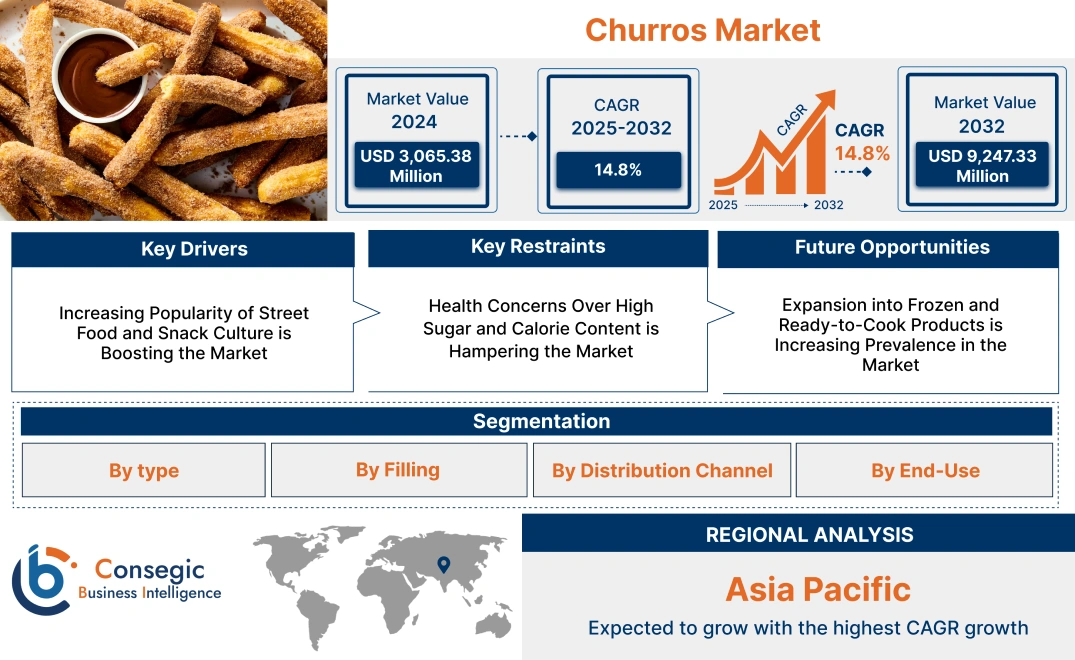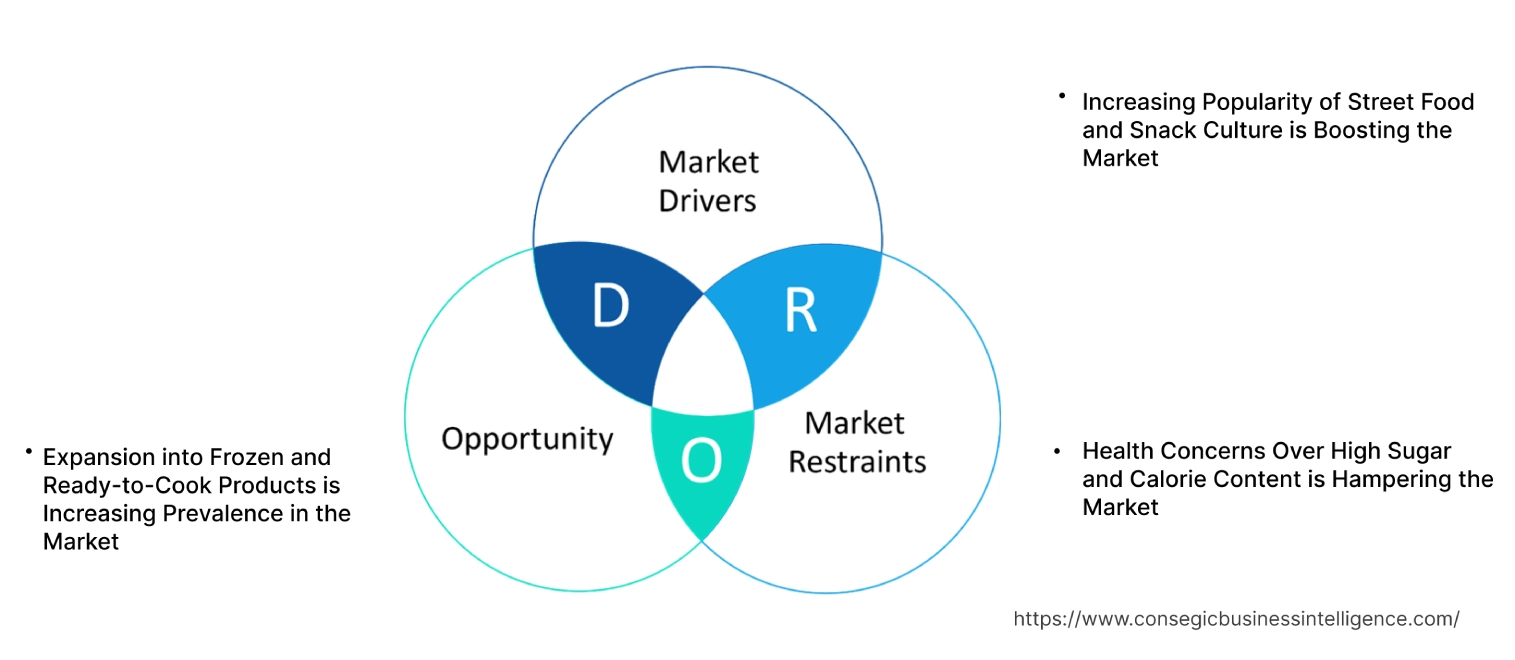- Summary
- Table Of Content
- Methodology
Churros Market Size:
Churros Market size is estimated to reach over USD 9,247.33 Million by 2032 from a value of USD 3,065.38 Million in 2024 and is projected to grow by USD 3,464.44 Million in 2025, growing at a CAGR of 14.8% from 2025 to 2032.
Churros Market Scope & Overview:
The churros are a popular fried-dough pastry originating from Spain and widely consumed globally as a dessert or snack. Known for their crisp exterior and soft interior, churros are often paired with accompaniments such as chocolate dips, cinnamon sugar, or fruit sauces. Key characteristics of churros include their versatility in preparation, customization with flavors and fillings, and suitability for a wide range of culinary settings. The benefits include high consumer appeal, ease of preparation, and adaptability to various cultural tastes. Applications span quick-service restaurants, cafes, bakeries, food trucks, and frozen ready-to-eat products in retail. End-users include food service providers, hospitality businesses, and individual consumers, driven by the increasing popularity of global cuisines, rising demand for indulgent snacks, and the expansion of bakery and confectionery markets worldwide.
Key Drivers:
Increasing Popularity of Street Food and Snack Culture is Boosting the Market
Churros have become a global favorite, fueled by the rising appeal of street food and snack culture. Their convenient portability, affordability, and versatile flavor profiles make them a popular choice among consumers seeking indulgent treats. Whether served plain, filled, or accompanied by dipping sauces, churros are a staple in food trucks, quick-service restaurants, and street vendors.
Trends in casual dining and on-the-go snacks are driving the wider availability of churros in both urban and suburban markets. As food festivals and pop-up events continue to flourish, churros are frequently featured as a signature offering, showcasing their cultural charm while adapting to modern consumer preferences. Analysis highlights that their position as a quintessential comfort snack makes them a key player in the global street food movement.
Key Restraints:
Health Concerns Over High Sugar and Calorie Content is Hampering the Market
Churros face scrutiny due to their high sugar and calorie content, which conflicts with the growing consumer trend toward healthier eating habits. The deep-fried nature of churros, combined with sugar coatings and indulgent fillings, makes them less appealing to health-conscious individuals who prioritize nutritional value and calorie control.
This challenge is particularly pronounced among consumers adhering to low-sugar, low-fat diets, or those concerned about long-term health impacts like diabetes and obesity. As awareness about these issues increases, churros may experience reduced acceptance unless businesses introduce healthier variations or portion-controlled servings. Addressing these concerns requires innovation in recipe development, focusing on baked options or alternative sweeteners to cater to evolving consumer priorities.
Future Opportunities :
Expansion into Frozen and Ready-to-Cook Products is Increasing Prevalence in the Market
The frozen food sector offers significant potential for churros, allowing consumers to enjoy this popular snack conveniently at home. Ready-to-cook churros, available in diverse flavors and customizable options, cater to the growing trend of convenience-driven purchasing behaviors. Retailers and manufacturers are increasingly exploring frozen churro products that deliver restaurant-quality taste with minimal preparation effort.
Trends in home dining and DIY culinary experiences have further boosted interest in frozen snacks. Analysis indicates that pre-packaged churros provide an opportunity to reach a broader audience, including families and individuals who prefer premium snacks without the hassle of sourcing fresh alternatives. By leveraging innovative packaging and freezing technologies, businesses can position churros as a versatile treat for any occasion, ensuring consistent market presence and consumer engagement.
Churros Market Segmental Analysis :
By Type:
Based on type, the market is segmented into frozen, ready-to-eat, and instant mix.
The frozen churros segment accounted for the largest revenue of 42.30% in churros market share in 2024.
- Frozen are widely preferred due to their convenience and ease of preparation, making them a popular choice for both retail consumers and food service outlets.
- These products allow for quick frying and serving, catering to the increasing trends for fast and delicious snacks.
- Frozen churros are extensively distributed through supermarkets, hypermarkets, and online channels, ensuring broad availability.
- The growing popularity of frozen snacks and the rising demand for ready-to-cook products in households have driven the dominance of frozen churros in the market analysis.
The ready-to-eat churros segment is anticipated to register the fastest CAGR during the forecast period.
- Ready-to-eat churros are gaining traction due to their convenience, availability, and suitability for on-the-go consumption.
- These products are particularly popular in food trucks, cafes, and specialty stores, where consumers seek quick and satisfying snacks.
- The rising trend of premium and gourmet churros in innovative flavors and formats is further fueling development in this segment.
- Additionally, the increasing presence of ready-to-eat churros in online retail channels is expected to drive significant churros market growth during the forecast period.
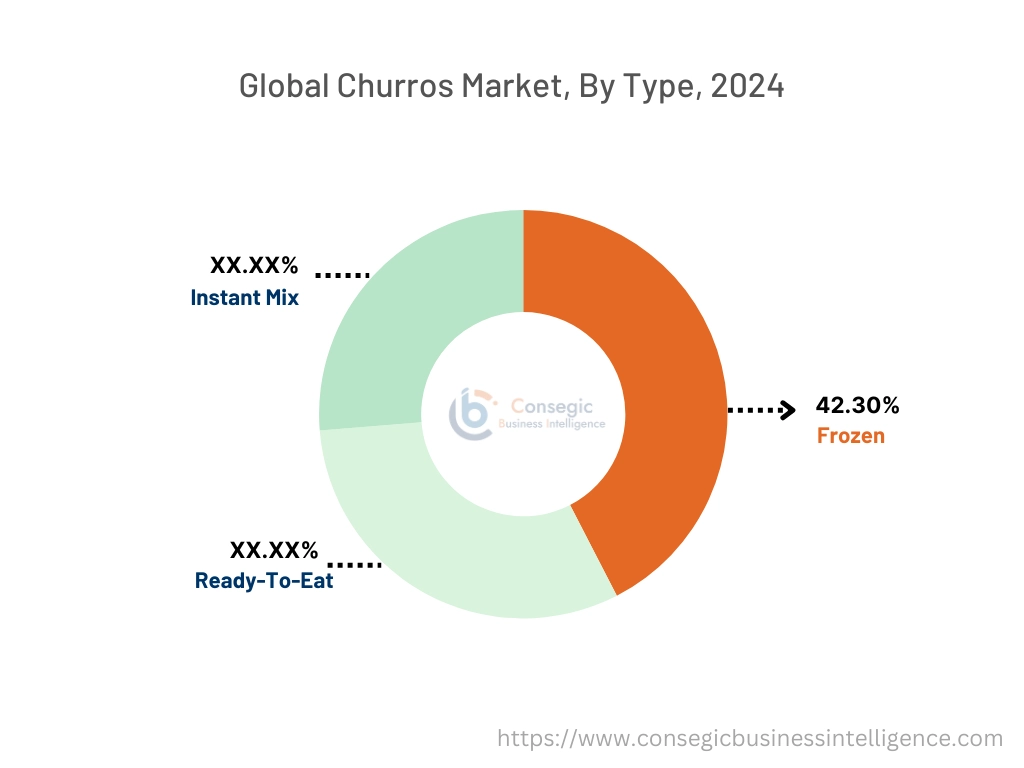
By Filling:
Based on filling, the market is segmented into filled churros and non-filled churros. The filled churros segment is further categorized into chocolate, caramel, fruit flavors, and others.
The filled churros segment accounted for the largest revenue of churros market share in 2024.
- Filled churros, particularly those with chocolate and caramel fillings, are highly popular among consumers for their rich taste and indulgent appeal.
- These churros are a staple in cafes, restaurants, and food trucks, offering variety and satisfying consumer preferences for sweet treats.
- The demand for innovative flavors such as fruit fillings and exotic combinations is driving the trends of this segment.
- Additionally, the rising trend of customized and premium churros with gourmet fillings has strengthened the dominance of filled churros in the market.
The non-filled churros segment is anticipated to register the fastest CAGR during the forecast period.
- Non-filled churros, known for their simplicity and versatility, are increasingly preferred for their traditional appeal and compatibility with various dipping sauces.
- These churros are widely consumed in food service outlets and households, catering to consumers who enjoy pairing churros with chocolate, caramel, or fruit-based dips.
- The growing interest in traditional and authentic food experiences is expected to drive the rapid growth of non-filled churros.
By Distribution Channel:
Based on distribution channel, the market is segmented into supermarkets & hypermarkets, convenience stores, online retail, specialty stores, and others.
The supermarkets & hypermarkets segment accounted for the largest revenue share in 2024.
- Supermarkets and hypermarkets remain the primary distribution channels for churros, offering a wide variety of products, including frozen and instant churros mixes.
- These retail outlets cater to a broad consumer base, providing convenience, accessibility, and promotional discounts.
- The increasing availability of premium and ready-to-eat churros in large retail chains has further boosted the segment’s dominance.
- Additionally, the rise of frozen snack sections in supermarkets has enhanced the visibility and trends for churros.
The online retail segment is anticipated to register the fastest CAGR during the forecast period.
- Online retail channels are rapidly gaining popularity for purchasing churros due to the convenience, variety, and promotional offers they provide.
- Consumers increasingly prefer online platforms for ordering frozen, instant, and gourmet churros due to doorstep delivery and flexible payment options.
- The extension of e-commerce platforms and the rising adoption of digital shopping trends, particularly among younger demographics, are expected to drive significant advancement in this segmental analysis.
By End-Use:
Based on end-use, the churros market is segmented into food service (cafes, restaurants, food trucks) and retail consumption (households).
The food service segment accounted for the largest revenue share in 2024.
- The food service sector, including cafes, restaurants, and food trucks, is the leading end-use industry for churros due to the high demand for freshly prepared and indulgent snacks.
- Churros are a staple in many cafes and dessert menus, offering a versatile and crowd-pleasing option for customers.
- The increasing trend of food trucks specializing in churros, often with innovative flavors and presentations, has further propelled the growth of this segment.
- Additionally, the rising popularity of churros as a festive and event-based dessert has boosted churros market trends in the food service sector.
The retail consumption segment is anticipated to register the fastest CAGR during the forecast period.
- Retail consumption of churros has grown significantly due to the rising availability of frozen, ready-to-eat, and instant churros mix in supermarkets, online platforms, and specialty stores.
- Households are increasingly purchasing churros for home preparation, driven by the convenience and the ability to customize flavors and toppings.
- The growing trend of enjoying café-style snacks at home is expected to drive the rapid growth of this segment during the forecast period.
Regional Analysis:
The regions covered are North America, Europe, Asia Pacific, the Middle East and Africa, and Latin America.
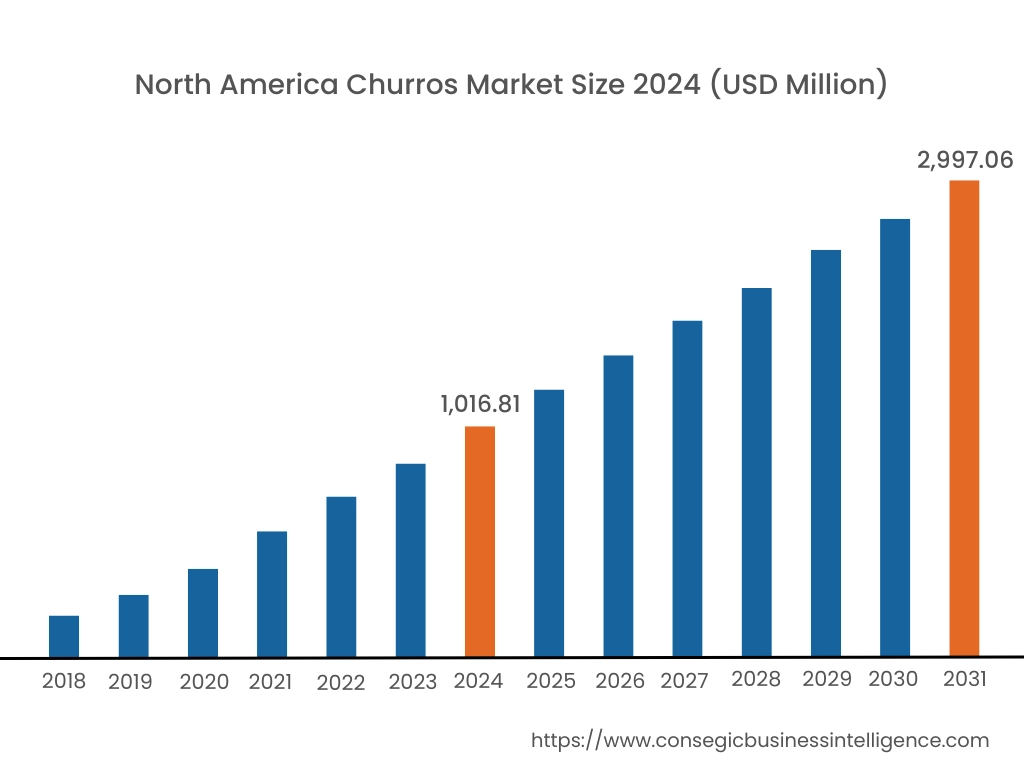
In 2024, North America was valued at USD 1,016.81 Million and is expected to reach USD 2,997.06 Million in 2032. In North America, the U.S. accounted for the highest share of 71.20% during the base year of 2024. North America holds a significant share in the churros market analysis, driven by the increasing popularity of Hispanic cuisine and the growth of fast-food chains offering churros as desserts or snacks. The U.S. dominates the region, with rising demand for churros in quick-service restaurants, food trucks, and supermarkets as a convenient and indulgent treat. The growing trend of frozen and pre-packaged churros for at-home consumption further boosts the market. Canada contributes to expanding adoption of churros in bakeries and cafes, catering to diverse consumer preferences. However, health concerns regarding sugary snacks may limit the churro market expansion.
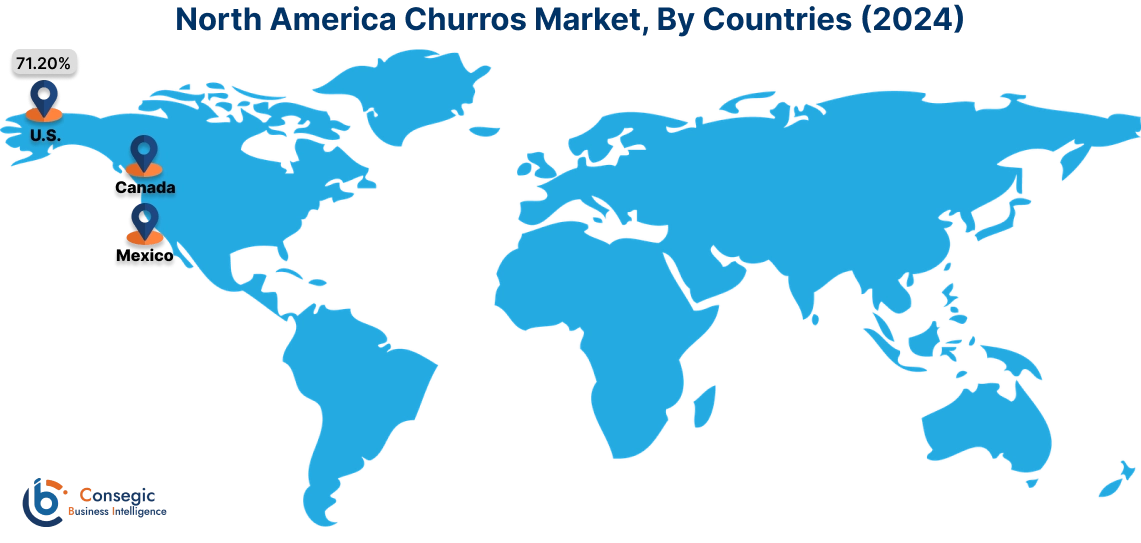
In Asia Pacific, the market is experiencing the fastest growth with a CAGR of 15.3% over the forecast period. The churros market is fueled by rising urbanization, changing food preferences, and the influence of Western food trends in China, India, and Japan. China leads the region with the increasing adoption of churros in cafes, food trucks, and international dessert chains. India’s growing middle class and urban youth drive trends for churros as a trendy dessert option, particularly in quick-service restaurants and malls. Japan focuses on premium and innovative churro offerings, incorporating unique flavors and presentation styles. However, the market may face challenges in less urbanized areas due to limited consumer familiarity with churros.
Europe is a prominent market for churros, supported by its rich culinary traditions and increasing churros market opportunities for authentic and premium bakery products. Countries like Spain, Portugal, and the UK are key contributors. Spain, the origin of churros, sees consistent demand from locals and tourists, with churros being a staple in cafes and breakfast menus. The analysis portrays Portugal as emphasizing traditional churros paired with hot beverages, while the UK witnesses the growing popularity of churros at food festivals, events, and restaurants. However, high competition from other baked goods and snacks may pose challenges to the market in some parts of the region.
The Middle East & Africa region is witnessing steady growth in the global churros market, driven by the rising influence of international cuisines and increasing churros market opportunities for sweet snacks. In the Middle East, countries like Saudi Arabia and the UAE are adopting churros in cafes, dessert parlors, and food trucks, appealing to a younger demographic. In Africa, South Africa is an emerging market, leveraging churros in urban cafes and bakeries to cater to the growing demand for Western-style desserts. However, limited local production and reliance on imports may restrict broader market development in the region.
Latin America is the largest market for churros, with deep cultural roots and widespread consumption across the region. Countries like Brazil, Argentina, and Mexico are key contributors. In Mexico, churros are a traditional street food staple, widely consumed with chocolate or other sweet dips. Brazil’s expanding cafe culture boosts churros market trends for churros in urban areas, while Argentina emphasizes churros as a popular snack in bakeries and roadside vendors. The region also sees innovation in churro recipes and fillings to cater to modern tastes. However, economic instability in some countries may limit the churros market expansion of commercial churro businesses.
Top Key Players and Market Share Insights:
The churros market is highly competitive with major players providing products to the national and international markets. Key players are adopting several strategies in research and development (R&D), product innovation, and end-user launches to hold a strong position in the churros market. Key players in the churros industry include -
- Churromania (USA)
- San Churro (Australia)
- Goya Foods (USA)
- Gold Medal Products Co. (USA)
- J&J Snack Foods Corp. (USA)
- La Lola Churreria (Philippines)
- Churro Borough (USA)
- Churros Factory (USA)
- Loop Churros (USA)
- Klosterman Baking Company (USA)
Recent Industry Developments :
Product Launch:
- In September 2024, Baileys introduced a limited-edition Cinnamon Churros Irish Cream Liqueur, combining the classic Irish cream with cinnamon and churros flavors. This product is versatile, suitable for consumption neat, over ice, or in cocktails, and pairs well with spirits like tequila, bourbon, whiskey, or aged rum. It is available for a limited time, with pricing and availability varying by location.
Churros Market Report Insights :
| Report Attributes | Report Details |
| Study Timeline | 2019-2032 |
| Market Size in 2032 | USD 9,247.33 Million |
| CAGR (2025-2032) | 14.8% |
| By Type |
|
| By Filling |
|
| By Distribution Channel |
|
| By End-Use |
|
| By Region |
|
| Key Players |
|
| North America | U.S. Canada Mexico |
| Europe | U.K. Germany France Spain Italy Russia Benelux Rest of Europe |
| APAC | China South Korea Japan India Australia ASEAN Rest of Asia-Pacific |
| Middle East and Africa | GCC Turkey South Africa Rest of MEA |
| LATAM | Brazil Argentina Chile Rest of LATAM |
| Report Coverage |
|
Key Questions Answered in the Report
What is the projected market size for churros by 2032? +
Churros Market size is estimated to reach over USD 9,247.33 Million by 2032 from a value of USD 3,065.38 Million in 2024 and is projected to grow by USD 3,464.44 Million in 2025, growing at a CAGR of 14.8% from 2025 to 2032.
What factors are driving the growth of the churros market? +
The rising popularity of street food culture, increasing demand for indulgent snacks, and growing adoption of churros in food service and retail sectors are key drivers of market growth.
What are the challenges faced by the churros market? +
Health concerns over high sugar and calorie content, along with competition from other bakery and snack items, pose challenges to market growth.
